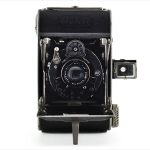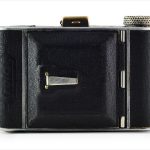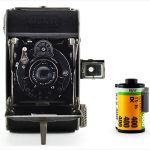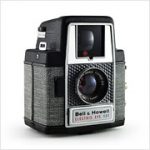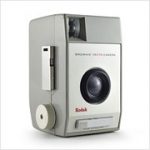Zeh Goldi Specifications
| Manufacturer: | Zeh-Camera-Fabrik |
| Origin: | German Reich |
| (modern day Germany) | |
| Made in: | Dresden, German Reich |
| (modern day Germany) | |
| Introduced: | 1932 |
| Type: | Folding, Viewfinder |
| Format: | 127 Film |
| Dimensions: | 7.5 x 11.8 x 3.5 cm (closed) |
| 9.4 x 11.8 x 9.1 cm (open) |
Zeh Goldi Overview
The Zeh Goldi is a small folding camera introduced by Dresden’s Zeh-Camera-Fabrik in 1932. Designed for Kodak’s 127 film format (often called vest pocket film), the Goldi is significantly smaller than the 35mm cameras that would eventually herald the end of 127 and is actually on par with many modern-day compact digital cameras.
When pressed, a small brass button on the Goldi’s top plate releases the lens. While the Goldi came with several different lenses, this one has a Zecanar-Anastigmat 50mm f/4.5 attached to a Gauthier Vario shutter with speeds ranging from 1/25-1/100 seconds, Time, and Bulb. A silver shutter lever can be found at the 10:30 mark on the lens barrel and a threaded cable release socket at 10. To push the lens back in and close the camera, there are two textured buttons at the top of the struts that must be pressed at the same time.
Next to the lens release button on the top plate is a flip-up viewfinder and next to that is the knurled film advance knob. A kickstand can be found on the lens door and the “Goldi” name embossed on the leatherette right next to it. There’s a 3/8″ tripod socket on the bottom plate, a sliding latch on the side to open up the back of the camera, and two red windows on the back to keep track of frame numbers.
I had been watching various eBay auctions for Zeh cameras for months and months before finally getting this Zeca Goldi for a very modest $20. The Goldi is in great cosmetic condition with only some minor brassing and wear on the leatherette. Mechanically, however, it’s wonderful. Despite being made in the 1930s, everything is tight and functioning exactly how it should. The springs and struts still have an astounding amount of tension in them and the lens pops out like it rolled of the assembly line just yesterday. Amazing.
Find your very own Zeh Goldi on eBay.
McKeown, James M. and Joan C. McKeown’s Price Guide to Antique and Classic Cameras, 2001-2002. (Grantsburg, WI, USA: Centennial Photo Service, 2001), p 708.




